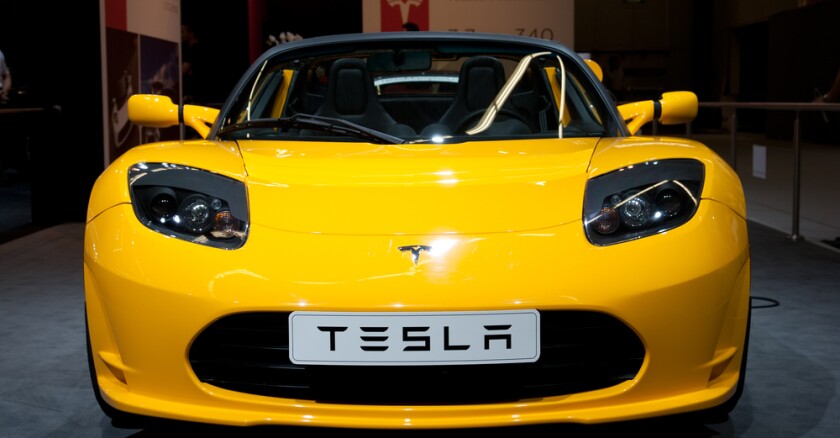On stage in front of a boisterous crowd of thousands of invited Tesla owners, company chief Elon Musk revealed that both all-wheel drive and semi-autonomous driving will soon be options on its pricey sport sedan.
"We were able to improve almost everything about the car," Musk told the crowd. "Acceleration is faster, top speed is faster, the efficiency increases. "
Thursday's announcements end two weeks of rampant speculation that media-savvy Musk ignited with a cryptic tweet. "About time to unveil the D and something else," he tweeted on Oct. 1.
The "D" refers to a new drive unit, or electric motor, powering the front wheels, giving the Model S all-wheel-drive capability. Current models offer only one drive unit, powering the rear wheels.
To a chorus of cheers, Musk said, "D stands for dual motor."
Then a massive robotic arm gripped an AWD Model S chassis and hoisted it onstage.
"Let's release the titan," Musk said.
"The thing that makes this unique and special, and better than all-wheel drive in the past, is because you can dynamically shift the power from front to rear at the millisecond level, more than is possible with a mechanically linked system," Musk said, referring to commonly used systems on other cars. "This is a digital system."
But the "something else" in Musk's tweet turned out to be the bigger news. Musk said Tesla will soon offer a suite of four safety systems that together offer a semi-autonomous driving experience.
They are: Forward-looking radar; a camera with image recognition that can read stop signs and identify objects before impact; 360-degree long-range sonar; and a system to integrate those features with navigation, GPS and real-time traffic data.
"The car can do almost anything," Musk said, though he conceded, "It's not at the level where you could safely fall asleep and arrive at your destination."
The new features will be available soon as part of a $4,250 technology package, which will include options already offered on the Model S.
Thursday's announcement could create buzz for Tesla, although the niche carmaker lags behind other mainstream luxury brands in introducing automated safety features, said Brian Johnson, senior research analyst for autos at Barclays Capital.
"Elon is going to get tremendous press for a feature he's going to have in showrooms," Johnson said, "while Mercedes flies under the radar with something that's in showrooms now."
Current versions of the Mercedes S-Class, as well as models from Acura, have robust radar-based cruise control and lane-keeping systems that take much of the effort out of freeway driving.
Many luxury cars for sale today also offer pre-collision braking that will automatically help stop the car if a driver fails to brake before impact. More basic systems can at least alert the driver that a collision is imminent.
The added attention from Tesla fans -- along with GM's announcement several weeks ago that its Cadillac brand will offer partial auto-pilot by 2017 -- could start "an arms race" among all automakers to get autonomous driving technology into showrooms, Johnson said.
Volvo hopes to have a similar system on the road by 2017; Audi by 2019; and Toyota by "mid-decade." These timelines and others could be accelerated, Johnson said.
Thursday's announcements also put to rest the rumors that Tesla would introduce a new vehicle called the "Model D," which were ignited by Musk's tweet last week. In fact, all-wheel-drive versions of the Model S will be called the 85D or 60D.
But Musk assured that the system transforms the car.
"The P85D has half again as much power," he said. "This car is nuts. It's like taking off from an aircraft carrier. It's like having your own personal roller coaster."
Musk, to loud applause, said the car would burn through a 0-to-60-mph run in 3.2 seconds.
"The target that we had for performance was to try to meet one of the greatest supercars of all time -- the McLaren F1," he said.
The second drive unit fills up a space under the car's hood that's used as a smaller trunk on the rear-wheel-drive Model S. So significant changes to the car were necessary to make the AWD system fit.
The setup is similar to the one on Tesla's forthcoming Model X crossover, due in 2015.
"If Tesla wants to be seen as a true competitor to brands like Audi, BMW, Jaguar and Mercedes-Benz, it needs to offer all-wheel drive on the current Model S sedan and upcoming Model X crossover," said Karl Brauer, senior analyst at Kelley Blue Book.
Eighty percent of Audis sold in the U.S. are AWD, while about half of all BMW and Mercedes models have it, according to Barclays' data.
Nearly every competing sedan or coupe in the Model S price range -- which starts at $72,000 and can run past $100,000 with options -- comes with some form of self-driving technology.
The all-wheel-drive system will be available on the performance-oriented P85 car in December, and on the two less expensive versions of the Model S in February. It will be a $4,000 option on the latter two -- in line with what other luxury brands charge for adding all-wheel drive.
The P85D will start at $120,000.
Adding both autonomous driving features and AWD to the current Model S makes plenty of sense, analysts say.
The upgrades give the car some shiny new options in lieu of the midlife redesign many mainstream cars get. Sales through September are down 3.2% versus the same period last year. Tesla sold 19,351 cars in the U.S. in 2013.
"I think Tesla thought the electric-only aspect of the Models S would sell a lot of cars, and now they're realizing there are other attributes that luxury buyers value," Johnson said.
___
(c)2014 the Los Angeles Times
Visit the Los Angeles Times at www.latimes.com
Distributed by MCT Information Services








